Climate and Climate Change
The marine biosphere; Wind driven ocean currents
1) The marine biosphere
Photosynthesis by microscopic organisms
known as phytoplankton is the base of the food chain that fuels the marine
biosphere. Phytoplankton are 'grazed' upon by microscopic animals
known as zooplankton which, in turn, are the food for the next higher links
on the food ladder, and so on.
Phytoplankton thrive only within the uppermost layer of the oceans where sunlight is available. Sunlight in the visible part of the spectrum (and especially the warm colors) is strongly absorbed by water. Hence, the sunlit 'euphotic zone' is restricted to the uppermost few tens of meters. Some creatures are able to live at greater depths, but nearly all the primary production of 'biomass' (i.e., plant matter in the bottom rung of the food ladder) takes place within the euphotic zone.
Phytoplankton also require nutrients (phosphorus, iron and other chemical species). Plankton 'blooms' would use up all the available nutrients in the euphotic zone within a matter of days if there were no way of replenishing the supply. Plankton and other living creatures that spend most of their lifetimes in the euphotic zone produce fecal matter that sinks to deeper layers and they eventually die and their remains sink into the darkness below. Fecal matter and dead organisms eventually decompose, but the freed up chemical nutrients do not become available to support the next generation of biomass until the ocean circulation lifts them back up into the euphotic zone. Hence, marine life tends to be concentrated in zones of 'upwelling' where nutrient rich water from below the euphotic zone emerges back into the sunlight.
The chlorophyll in the living tissue of
phytoplankton imparts a greenish color to sea water in regions of strong
primary productivity. The distinction on color is visible to the
naked eye, and it is highly visible when the surface of the ocean is scanned
with an instrument that responds strongly to green light. This is
the principle behind the design of NASA's
SeaWIFS instrument. Below are some of the images we looked at
in class. They show the concentrations of chlorophyll in the oceans
(which reflects marine productivity) as well as vegetation on land through
the four seasons.
|
|
|
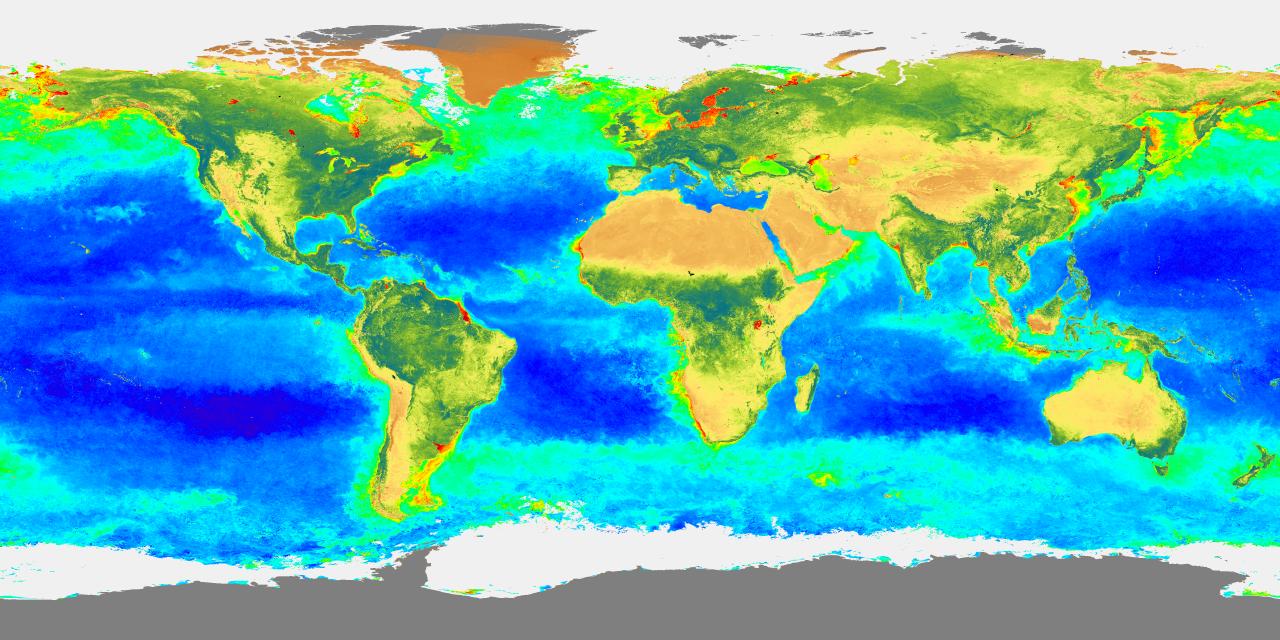 |
 |
|
|
|
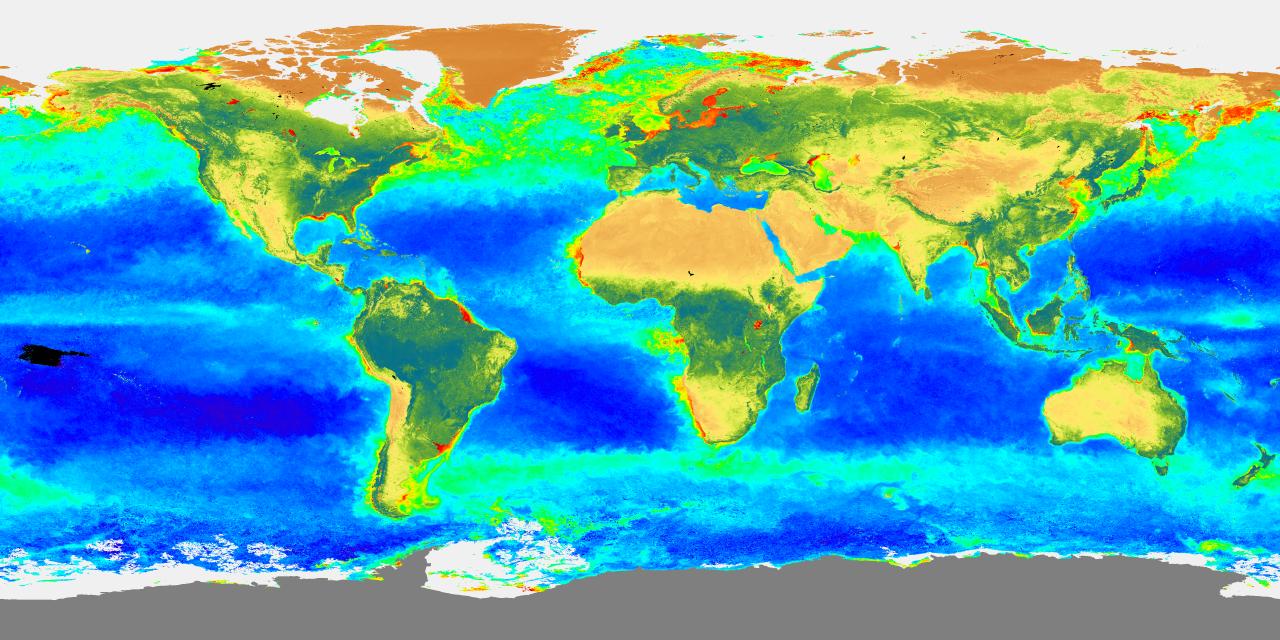 |
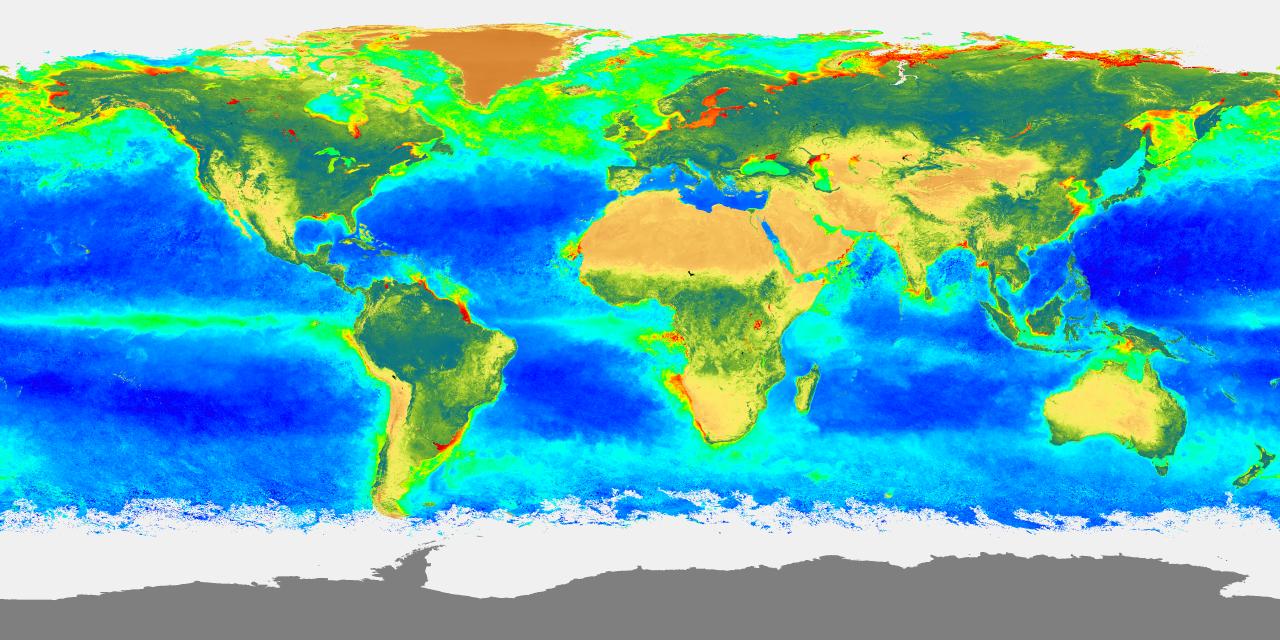 |
 |
Fig. 1. SeaWIFs images of the global biosphere
in fall, winter, spring and summer. Click on the images to see larger versions
of these images. More images can be found at: http://seawifs.gsfc.nasa.gov/
SEAWIFS/IMAGES/SEAWIFS_GALLERY.html |
Areas of the oceans that are light blue-green correspond to waters with high concentrations of phytoplankton and thus high productivity of the biosphere. Dark blue areas and the "deserts" of the oceans, without much productivity.
Upwelling areas (nutrient rich areas with many phytoplanton) tend to be concentrated within
- (a) regions where the wind and ocean currents circulate 'cyclonically' (in the same sense as the Earth's rotation: counterclockwise in the Northern Hemisphere and clockwise in the Southern Hemisphere); these areas show up clearly in the SeaWIFS images above (North Atlantic and North Pacific Oceans; as well as high latitude ocean waters in the southern hemisphere)
- (b) in certain coastal regions
- (c) and along the equator wherever winds blow from east to west (close to the ITCZ).
The reasons for this will be discussed
below in the section on the wind driven ocean circulation. These
upwelling regions show up clearly in the SeaWIFS imagery. They are
the sites of the world's most productive fisheries.
2. Vertical structure of the oceans
In contrast to the typical situation in
the atmosphere, temperature in the ocean usually increases with height
(or decreases with depth). You may have experienced this while swimming
in a cold lake on the first hot day of summer when the surface water may
feel quite comfortable while the water just a few feet below the surface
is
still quite cold. The density of
water decreases with temperature, so the thin layer of warm water near
the surface is floating on top of a layer of denser water. If a wind
comes up and creates waves, the warm water near the surface will be mixed
with the colder water below. The stronger the wind and the longer
it blows, the deeper the 'mixed layer'.
A deep mixed layer exists over most of
the ocean. Its thickness ranges from a few tens of meters up to a
few hundreds of meters. At the bottom of the mixed later lies a layer
in which the temperature decreases rapidly with depth: rapidly at first,
and then more gradually until it eventually levels off at 39°F (4°C
, the temperature of 'bottom water'). The top (or upper part) of
this transition layer is called the thermocline.
3) The wind driven ocean circulation
The surface winds over the oceans tend to drag the surface waters with them. In the Pacific and Atlantic, where there are well defined northeasterly and southeasterly trades, the surface currents in the tropics are westward, and over the westerly wind belt from 40 to 60 degrees latitude, the prevailing currents are eastward. The continents block the eastward and westward currents, thereby causing the surface waters to circulate around anticyclonic (clockwise in the Northern Hemisphere; counterclockwise in the Southern Hemisphere) gyres, centered at subtropical latitudes as shown in Fig. 5-2 and 5-3 of the text. At higher latitudes there are smaller gyres that circulate in the opposite (cyclonic) sense. The surface currents over the Indian Ocean is not as distinct because the winds that drive it reverse with the seasons.
The 'dragging' of the surface waters by
the winds implies a transfer of momentum from the atmosphere to the oceans:
hence the term, 'wind driven'. The actual momentum transfer is accomplished
through the generation and dissipation of surface waves, which move in
the same direction as the wind. The up and down motions caused by
surface waves extend to a depth of only a few tens of meters, but the wind
driven currents extend deeper into the ocean due to processes related to
the Earth's rotation.
4) Role of the Earth's rotation
We can explain how the earth's rotation affects the wind driven gyres in the ocean circulation by invoking the Coriolis force, which has the following properties:
(1) it is directly proportional to the horizontal velocity of the ocean currents (i.e., it affects only moving objects on a rotating planet)
(2) it is proportional to rotation rate (i.e., to have a Coriolis force, the planet has to be rotating
(3) its horizontal component, which is what we care about, is proportional to the sine of the latitude: i.e., it is zero right on the equator, it increases with latitude
(4) it is directed to the right of the wind driven currents in the Northern Hemisphere and to the left of them in the Southern Hemisphere. Hence it reverses sign when one crosses the equator.
It is possible to illustrate the effect
of the Coriolis force by having an observer position herself at the North
pole and throw a ball at target T (see Fig. 2 below). It takes
a certain time for the ball to reach the target, during which time the
target will have moved a certain distance as a result of the Earth's rotation,
causing the ball to miss the target. The rotating observer at the North
Pole (moving with the Earth) does not perceive the target as having moved,
because her frame of reference is moving
with it. But the shot missed nonetheless. From the perspective of
the observer, the ball has been deflected to the right of the target by
an apparent force that we refer to as the Coriolis force.

Fig. 2 Coriolis effect for rotating observer at North Pole (from Introduction to Atmospheric Chemistry by D.J. Jacob, Princeton University Press).
We can repeat the same type of thought
experiment by positioning the observer at a given latitude in the Northern
Hemisphere and having her throw the ball at a target North of her position.
The result will be the same: the ball will appear to have been deflected
to the right of the target. For an more detailed explanation of the Coriolis
Force see p. 82-84 of the text.
Example: movie of a ball rolling
across the surface of a rotating merry-go-round.
Quicktime
(2.0M)
MPEG
(0.9M)
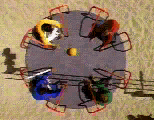
The Coriolis force acts to deflect the
surface currents circulating around the subtropical gyres inward toward
the center of the gyres, as pictured in the upper panel of the figure below.
The accumulation of surface waters in the interior of the gyre causes downwelling
(as shown), which causes the nutrients to be positioned deeper in the
water column than they are elsewhere in
the world ocean. The deeper the nutrients, the less likely they are
to be brought up into the euphotic zone by wind driven mixing. Hence,
the marine biosphere is relatively inactive in the subtropical gyres: the
waters are relatively clear (chlorophyll free) and show up dark blue in
the
SeaWIFS imagery.
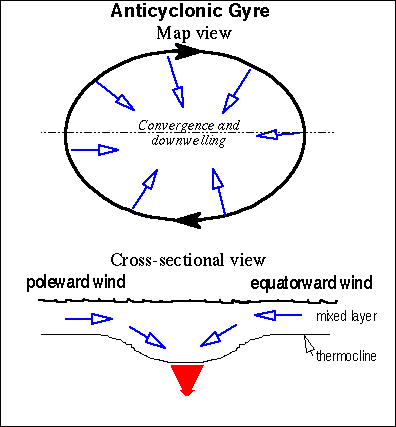 |
 |
For the same reason, the surface waters circulating in the cyclonic gyres on the poleward side of the westerly wind belts is deflected outward, pulling the thermocline (and the nutrients) upward in the center of the gyre, which tends to enhance the production of chlorophyll (and fish) in these regions. The tight cyclonic circulations in hurricanes are sometimes strong enough to bring the thermocline right up to the surface within a matter of a day or two, leaving behind a patch of conspicuously cold water.
Very strong coastal upwelling is observed in regions where the surface winds circulating around the subtropical anticyclones blow parallel to the coastlines. One of these regions is the coast of Oregon and Northern California during summertime. The northerly (north to south) wind around the eastern side of the subtropical (Pacific) gyre drives a strong north to south coastal current which is deflected toward the right-- away from the coastline. As the surface water drift offshore, they are replaced by cold, nutrient rich subsurface waters. In a typical summer there may be intervals of a week or two when the northerly winds weaken and the upwelling stops. Within a few days the surface nutrients are used up, the biosphere goes dormant and the quality fishing abruptly declines. At such times, those whose livelihood depends on fishing watch the weather forecasts for a sign of the return of the northerlies. Other area where coastal upwelling occurs include the coasts of northern Chile and Peru and West Africa.
Equatorial upwelling occurs wherever the winds blow from the east. Surface waters just to the north of the equator are deflected toward the north and surface waters just to the south of the equator are deflected toward the south. As the surface waters drift away from the equator (in both directions) the equatorial thermocline bulges up, close enough to the surface so that mixing from the surface waves can stir nutrients upward into the euphotic zone where phytoplankton can feed on it. Hence the equatorial belt shows up bright green in the SeaWIFS images. The zone is narrow because the phytoplankton growing in the upwelled water go through their life cycle in just a day or two-- not long enough for the upwelled water to diverge more than a few tens of km from the equator.
Last
Updated:
01/23/2002